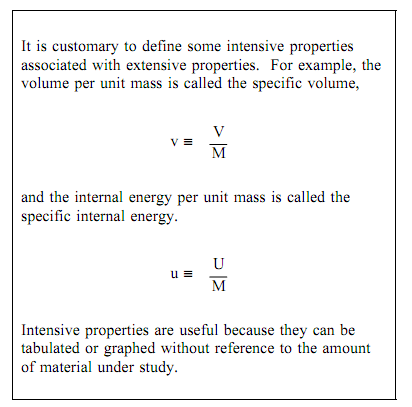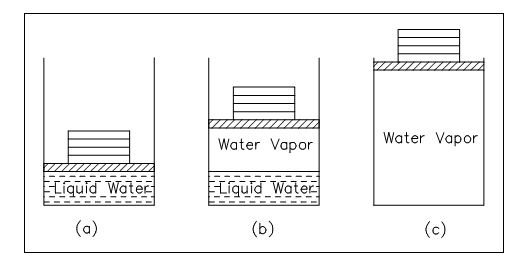Classification of Properties
The properties are categorized as either extensive or intensive. The properties are intensive when independent of the quantity of mass present and extensive when a function of the quantity of mass present. The properties like temperature, pressure, and density are intensive, while volume and mass are extensive. The extensive property might be made intensive by dividing the specific property by the total mass. The total volume (V), that is an extensive property, can be changed to specific volume, that is an intensive property, by dividing the mass of the system, ν = V/m. Any specific property (i.e., specific enthalpy, specific volume, specific entropy), is an intensive property, as indicated in the figure below.

Figure: Intensive Properties
The use of extensive and intensive properties is elaborated in the discussion below. Consider as a system 1 lbm of water enclosed in the piston-cylinder arrangement shown in figure below. Assume that the piston and weight maintain a pressure of 14.7 psia in the cylinder and which the initial temperature is 60°F, portion (a) of figure below. Since heat is transferred to the water, the temperature rises. The specific volume rises slightly, and the pressure stays constant. Whenever the temperature attains 212°F, extra heat transfers outcomes in a change in phase (boiling), as indicated in portion (b).

Figure: Piston-cylinder Arrangement
That is, a few of the liquid becomes vapor and both the temperature and pressure stay constant, though the specific volume rises considerably. Whenever the last drop of liquid is vaporized, more transfer of heat outcomes in a rise in both temperature and specific volume of the vapor, portion (c). In this illustration, temperature and pressure are intensive, and thus do not based upon the quantity of mass present. By inspecting the specific volume (i.e., an intensive property) of the water in the piston rather than the volume (i.e., an extensive property), we can inspect how any portion of the water in the piston modifies. The volume by itself tells us not anything about the water in the piston. Though, by knowing the specific volume we can tell when the water is a liquid or steam.